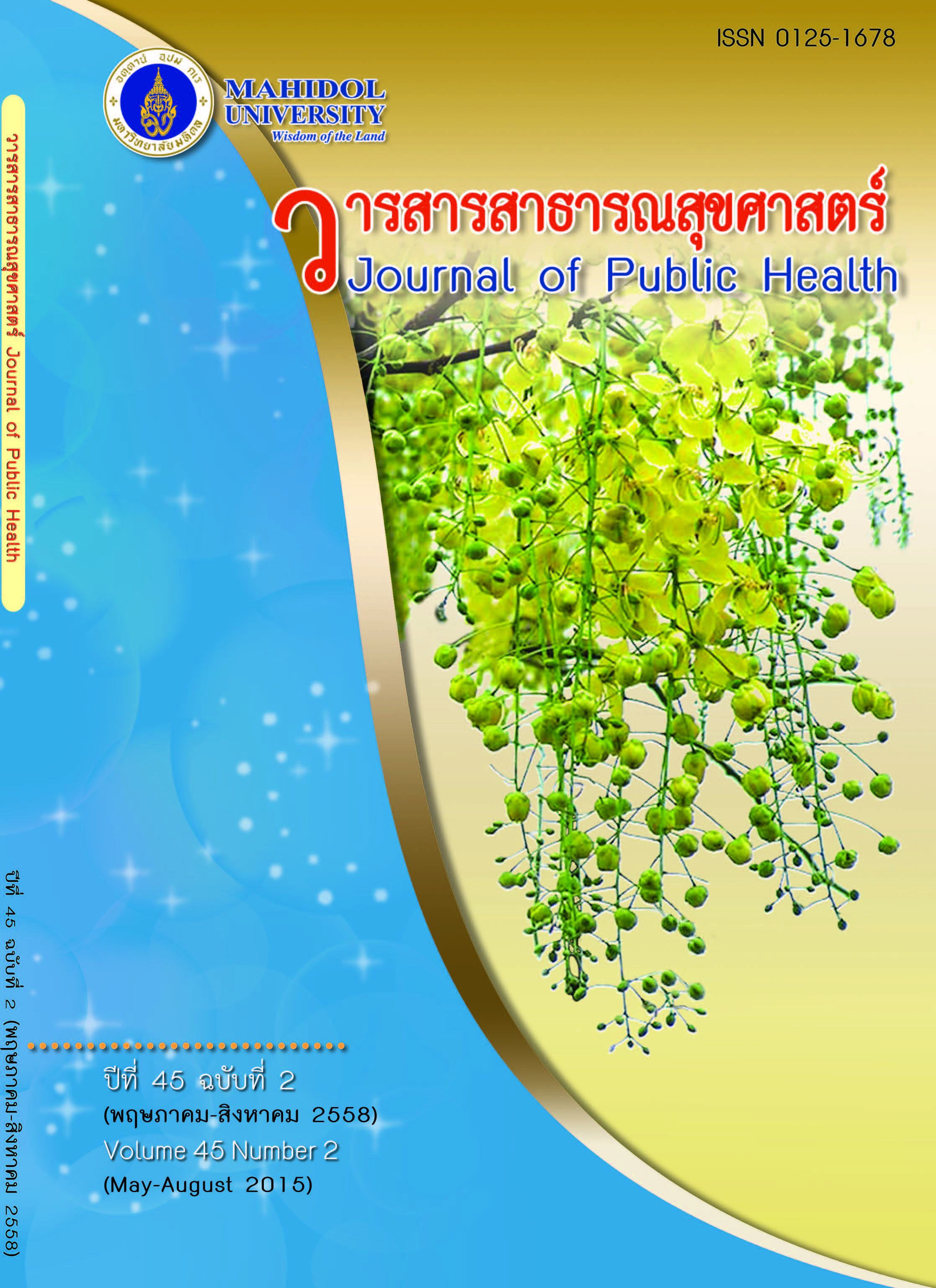ปัจจัยทำนายภาวะสุขภาพของอาสาสมัครสาธารณสุขประจำหมู่บ้าน
Keywords:
ภาวะสุขภาพ, อาสาสมัครสาธารณสุขประจำหมู่บ้านAbstract
บทคัดย่อ
ปัจจุบันโรคไม่ติดต่อเรื้อรังได้เพิ่มมากขึ้นในประชากรไทย ระดับความดันโลหิต ระดับน้ำตาลในเลือด ดัชนีมวลกายและภาวะอ้วนลงพุงเป็นตัวชี้วัดภาวะสุขภาพที่สำคัญของโรคไม่ติดต่อเรื้อรัง การวิจัยเชิงสำรวจนี้มีวัตถุประสงค์เพื่อศึกษาปัจจัยทำนายภาวะสุขภาพของอาสาสมัครสาธารณสุขประจำหมู่บ้าน จำนวน 360 คน ในอำเภอแห่งหนึ่ง จังหวัดปทุมธานี รวบรวมข้อมูลระหว่างเดือนกันยายนถึงธันวาคม 2557 โดยการสอบถามความรู้เกี่ยวกับพฤติกรรมสุขภาพ พฤติกรรมสุขภาพ 3อ. 2ส. วัดความดันโลหิต เจาะน้ำตาลปลายนิ้ว วัดส่วนสูง ชั่งน้ำหนักและวัดรอบเอว วิเคราะห์ข้อมูลด้วยสถิติไคว์สแควและการถดถอยโลจิสติก ผลการวิเคราะห์พบว่า เพศ อายุ ดัชนีมวลกาย พฤติกรรมการดื่มเครื่องดื่มที่มีแอลกอฮอล์และการสูบบุหรี่เป็นปัจจัยที่สัมพันธ์กับระดับความดันโลหิตอย่างมีนัยสำคัญทางสถิติ (p < 0.05) โดยปัจจัยที่สามารถทำนายระดับความดันโลหิต ได้แก่ เพศ (odd ratio = 3.38, 95% CI = 1.85-6.17, p < 0.001) อายุ (odd ratio = 1.06, 95% CI = 1.03-1.10, p < 0.001) และดัชนีมวลกาย (odd ratio = 1.10, 95% CI = 1.04-1.17, p = 0.001) ดังนั้นจึงควรรณรงค์ให้มีกิจกรรมเฝ้าระวังและควบคุมน้ำหนักตัวที่ถูกต้อง เพิ่มความตระหนักถึงผลเสียของการมีน้ำหนักเกินโดยเฉพาะอย่างยิ่งในอาสาสมัครเพศชายที่มีน้ำหนักเกินเกณฑ์และกลุ่มที่มีอายุมาก
ABSTRACT
Currently, non-communicable diseases are increasing in the Thai population. Blood pressure, blood sugar levels, body mass index (BMI), and abdominal obesity are the important indicators for measuring non-communicable diseases. This cross-sectional study aimed to examine the factors affecting health among village health volunteers. The sample included 360 village health volunteers in Pathum Thani province during September-December 2014. Data were collected using questionnaires on health information, knowledge of health behaviors, and health behaviors. BMI, waist circumference, blood pressure, and blood glucose (fingertip) were assessed. Data were analyzed using descriptive statistics, chi-square test and binary logistic regression. The chi-square test revealed that the factors affecting blood pressure level were gender, age, BMI, alcohol drinking, and cigarette smoking. (p < 0.05) The blood pressure level should be predicted by gender (odd ratio = 3.38, 95% CI = 1.85-6.17, p < 0.001), age (odd ratio = 1.06, 95% CI = 1.03-1.10, p < 0.001) and BMI (odd ratio = 1.10, 95% CI = 1.04-1.17, p = 0.001). Therefore, conducting a campaign to surveillance and control weight should be done and raising awareness of the negative effects of being overweight especially in male volunteers who are overweight and the aged groups should implement.
Downloads
Published
Issue
Section
License
Creative Commons License CC-BY-ND


